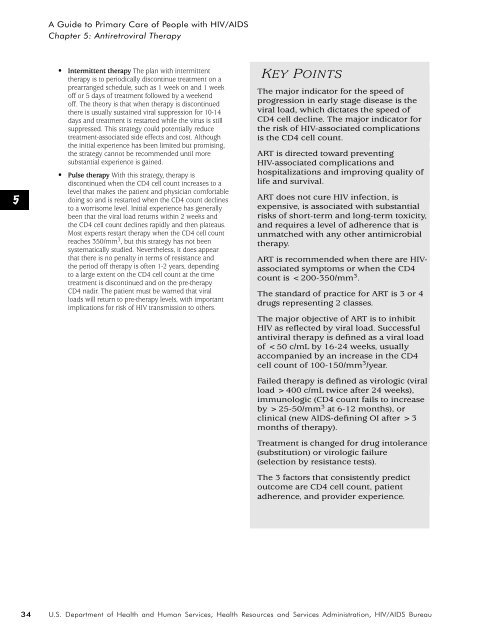A Guide to Primary Care of People with HIV/AIDS - Canadian Public ...
A Guide to Primary Care of People with HIV/AIDS - Canadian Public ...
A Guide to Primary Care of People with HIV/AIDS - Canadian Public ...
You also want an ePaper? Increase the reach of your titles
YUMPU automatically turns print PDFs into web optimized ePapers that Google loves.
A <strong>Guide</strong> <strong>to</strong> <strong>Primary</strong> <strong>Care</strong> <strong>of</strong> <strong>People</strong> <strong>with</strong> <strong>HIV</strong>/<strong>AIDS</strong><br />
Chapter 5: Antiretroviral Therapy<br />
5<br />
• Intermittent therapy The plan <strong>with</strong> intermittent<br />
therapy is <strong>to</strong> periodically discontinue treatment on a<br />
prearranged schedule, such as 1 week on and 1 week<br />
<strong>of</strong>f or 5 days <strong>of</strong> treatment followed by a weekend<br />
<strong>of</strong>f. The theory is that when therapy is discontinued<br />
there is usually sustained viral suppression for 10-14<br />
days and treatment is restarted while the virus is still<br />
suppressed. This strategy could potentially reduce<br />
treatment-associated side effects and cost. Although<br />
the initial experience has been limited but promising,<br />
the strategy cannot be recommended until more<br />
substantial experience is gained.<br />
• Pulse therapy With this strategy, therapy is<br />
discontinued when the CD4 cell count increases <strong>to</strong> a<br />
level that makes the patient and physician comfortable<br />
doing so and is restarted when the CD4 count declines<br />
<strong>to</strong> a worrisome level. Initial experience has generally<br />
been that the viral load returns <strong>with</strong>in 2 weeks and<br />
the CD4 cell count declines rapidly and then plateaus.<br />
Most experts restart therapy when the CD4 cell count<br />
reaches 350/mm 3 , but this strategy has not been<br />
systematically studied. Nevertheless, it does appear<br />
that there is no penalty in terms <strong>of</strong> resistance and<br />
the period <strong>of</strong>f therapy is <strong>of</strong>ten 1-2 years, depending<br />
<strong>to</strong> a large extent on the CD4 cell count at the time<br />
treatment is discontinued and on the pre-therapy<br />
CD4 nadir. The patient must be warned that viral<br />
loads will return <strong>to</strong> pre-therapy levels, <strong>with</strong> important<br />
implications for risk <strong>of</strong> <strong>HIV</strong> transmission <strong>to</strong> others.<br />
KEY POINTS<br />
The major indica<strong>to</strong>r for the speed <strong>of</strong><br />
progression in early stage disease is the<br />
viral load, which dictates the speed <strong>of</strong><br />
CD4 cell decline. The major indica<strong>to</strong>r for<br />
the risk <strong>of</strong> <strong>HIV</strong>-associated complications<br />
is the CD4 cell count.<br />
ART is directed <strong>to</strong>ward preventing<br />
<strong>HIV</strong>-associated complications and<br />
hospitalizations and improving quality <strong>of</strong><br />
life and survival.<br />
ART does not cure <strong>HIV</strong> infection, is<br />
expensive, is associated <strong>with</strong> substantial<br />
risks <strong>of</strong> short-term and long-term <strong>to</strong>xicity,<br />
and requires a level <strong>of</strong> adherence that is<br />
unmatched <strong>with</strong> any other antimicrobial<br />
therapy.<br />
ART is recommended when there are <strong>HIV</strong>associated<br />
symp<strong>to</strong>ms or when the CD4<br />
count is 25-50/mm 3 at 6-12 months), or<br />
clinical (new <strong>AIDS</strong>-defining OI after >3<br />
months <strong>of</strong> therapy).<br />
Treatment is changed for drug in<strong>to</strong>lerance<br />
(substitution) or virologic failure<br />
(selection by resistance tests).<br />
The 3 fac<strong>to</strong>rs that consistently predict<br />
outcome are CD4 cell count, patient<br />
adherence, and provider experience.<br />
34<br />
U.S. Department <strong>of</strong> Health and Human Services, Health Resources and Services Administration, <strong>HIV</strong>/<strong>AIDS</strong> Bureau

















